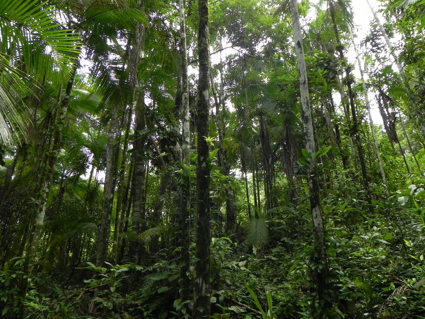Tropical Restored Forests as Sustainable Production Systems
Brancalion, P.H.S. 2018. Promoting tropical forest restoration in Brazil through timber and non-timber forest products. Current Conservation 12.1: 17-20. https://www.currentconservation.org/issues/promoting-forest-restoration-in-brazil-through-timber-and-non-timber-forest-products/
Tropical forests have been destroyed worldwide for expanding agricultural areas. The replacement of such carbon- and biodiversity-rich ecosystems by agricultural lands have been motivated by one simple reason: providing direct financial benefits to landholders. Although tropical forests have been a huge shopping mall for indigenous and local communities, from where they obtain many benefits, the global demand for few agricultural products have pushed these multipurpose systems to an unprecedented level of social and environmental simplification. The restoration of tropical forests in pastures and agricultural lands has been stimulated in many global regions as a means to obtain different kinds of benefits, such as watershed protection, climate change mitigation, and biodiversity conservation. In spite of the overarching benefits of restoration for society in general, farmers also need direct financial benefits from restoration to compensate for lack of income from agricultural land uses.

A second-growth forest managed for harvesting fruits of Euterpe edulis in Brazil’s Atlantic Forest (photo by Robin Chazdon)
In the Atlantic Forest region of Brazil, many alternative restoration models, focused on the production of timber and non-timber forest products from native palm and tree species, demonstrate that tropical forest restoration can lead to a financially viable land use. These restoration models were developed based on the selection of species with potential market demand and their cultivation according to favorable forestry techniques (planting density, shading, spatial distribution, thinning) to support their growth and easy harvesting. Selected species include those heavily exploited historically from forest remnants because of their economic value as well as species that provide fruits, cosmetics and medicines. In addition to providing income to farmers, such productive restoration approaches may also increase the quality of life of urban people, by allowing them to rediscover the taste, color, shape, texture, cure potential, and beauty of nature. Life can be much richer this way.
The PARTNERS connection
This article is part of a special issue of Current Conservation magazine. Current Conservation is published by an informal alliance of organizations to promote interdisciplinary research in conservation and to foster communication among scientists, students, resource managers, educators and policy makers. The six articles in this issue were written by PARTNERS members and focus on different aspects of forest restoration in the tropics. Each article is illustrated with unique artwork, infographics and photographic images from contributors across the world.



